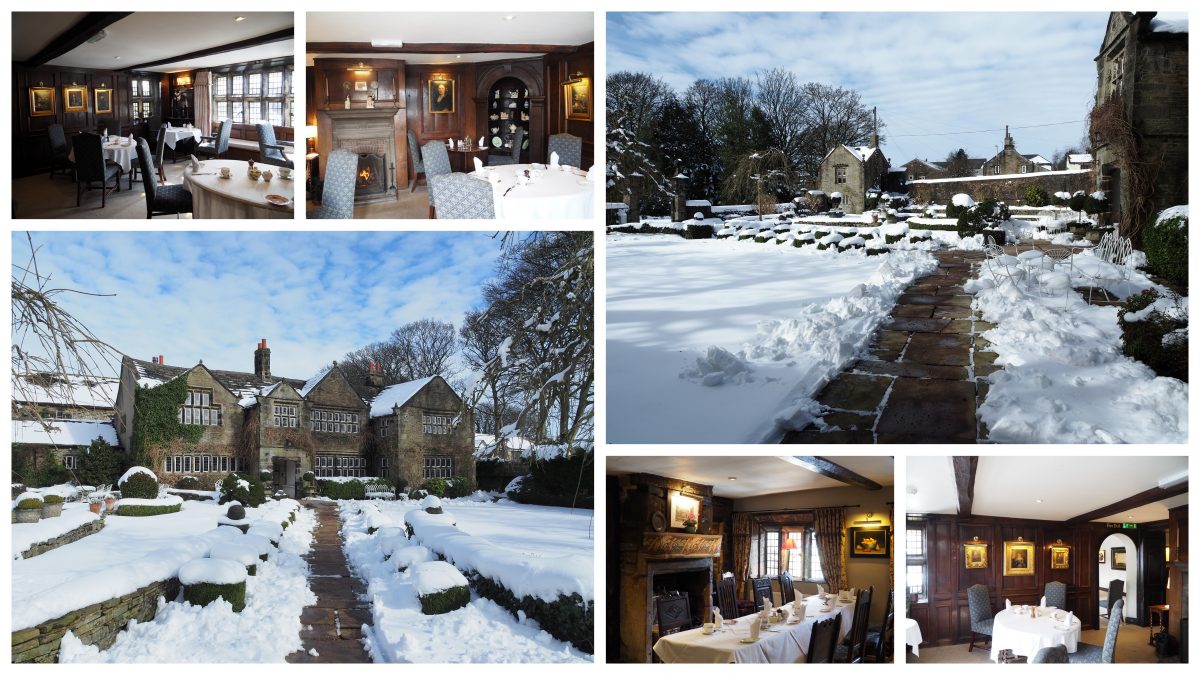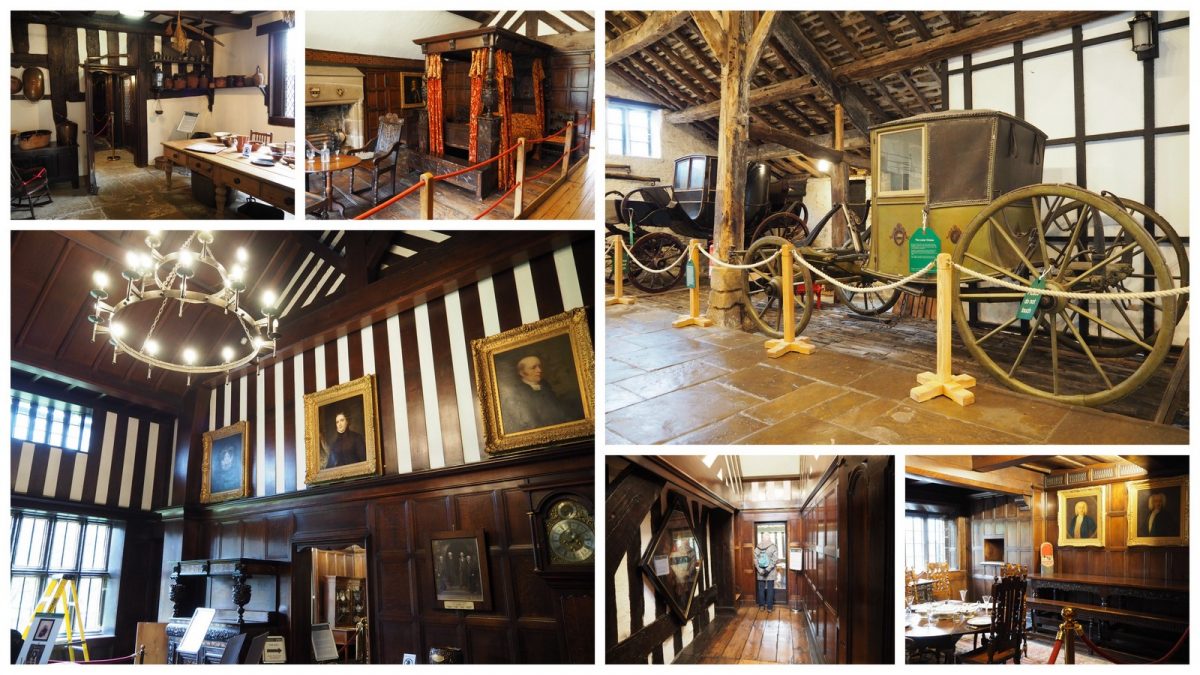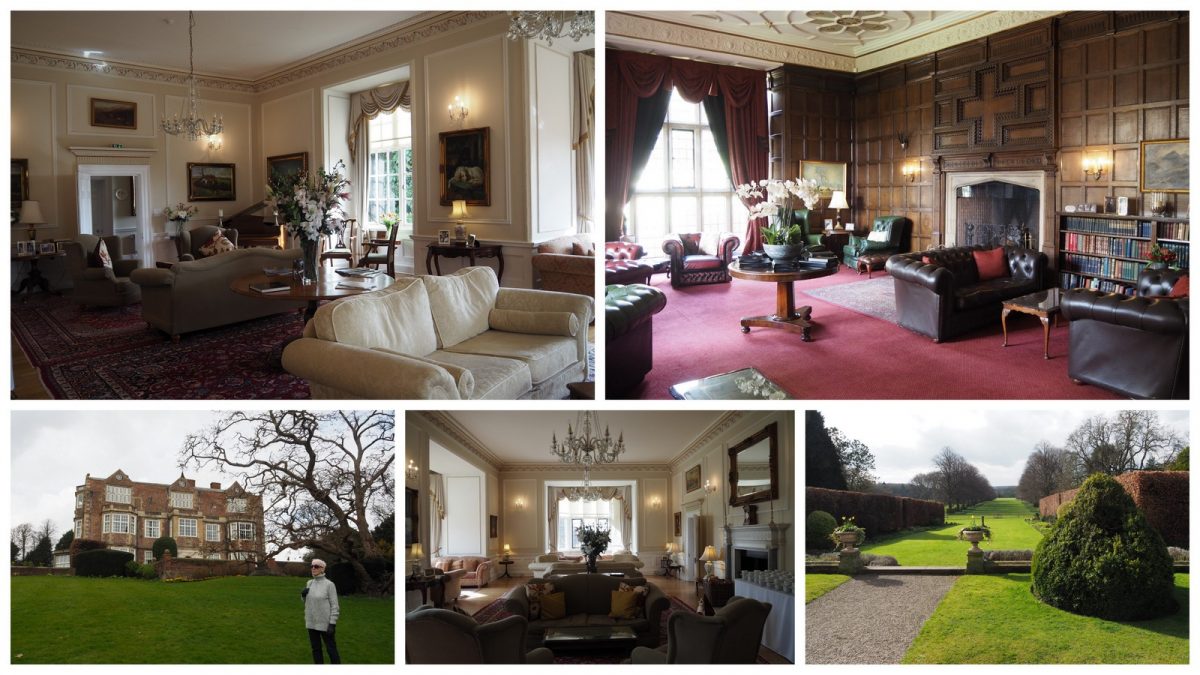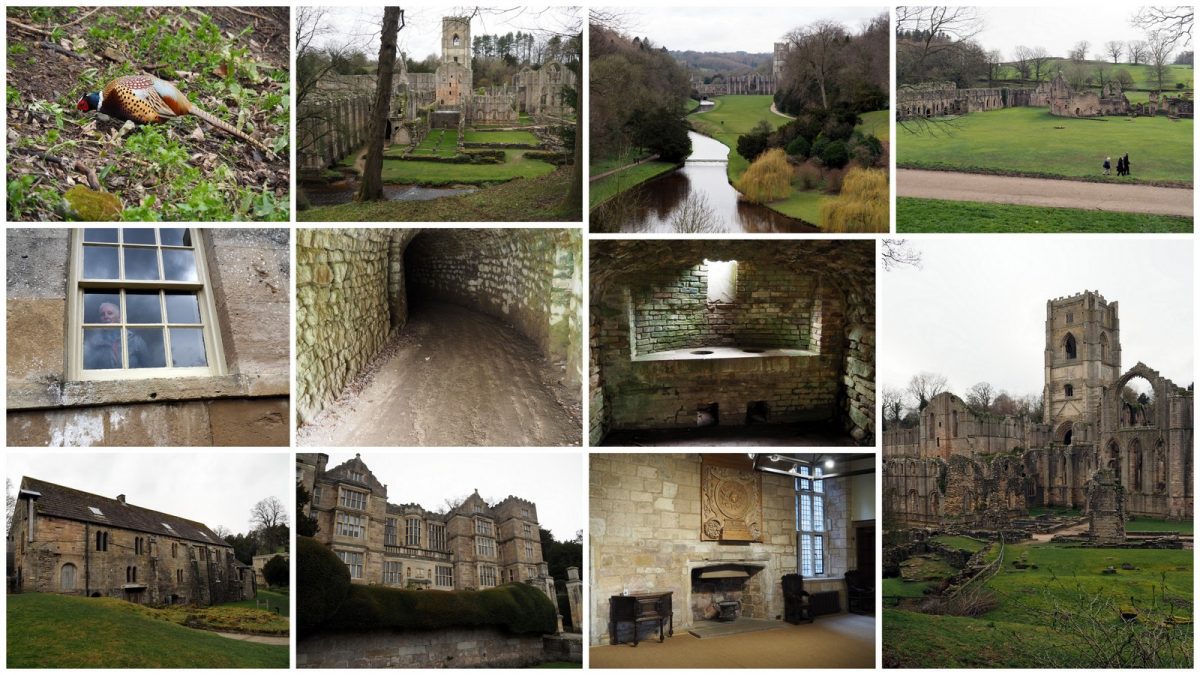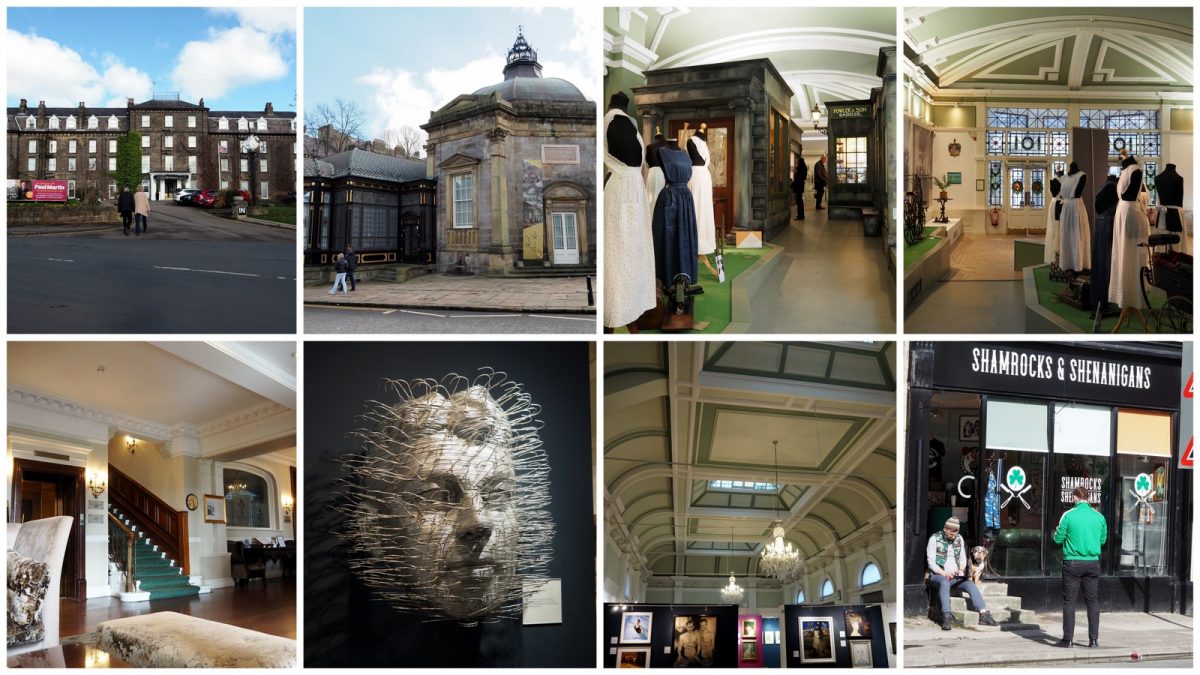Or indeed, a trip to God’s Country I suppose, but I’ve always been an introverted Yorkshireman, so I draw the line at County rather than drawing parallels between my county of birth and the whole of the country – it wouldn’t do the latter any favours he says with fervour. We could have done without the unseasonably cold snap, where the heavy snow put the first two legs in serious jeopardy! Then again, I didn’t expect a simple invitation to an 80th birthday lunch for Mrs. No Name’s cousin to lead to a fourteen day sojourn and five hotel stays either….
As has become standard practice, we broke our journey with an overnight stop at the now customary and excellent Wentbridge House Hotel; this time we just went B&B and had an evening meal in the nearby pub. The food was fine but we did have to walk the five minutes back to the hotel in another snowstorm. If truth be told, the next destination was only around thirty five miles so we didn’t really need the stopover but it’s almost a tradition now whenever we travel up the A1. Checked with the next hotel by phone in the morning and was told the roads were pretty much clear in the Halifax area so we decided to press on.
After a slow but relatively safe passage along the M62 (not at all like the chaos of the previous night, discovered later that day on the local news), we arrived, with a minor navigational discrepancy, at the Holdsworth House Hotel. We arrived very early but they were very accommodating and checked us in there and then. Family owned for sixty years, this historic Jacobean manor is a much-loved, four-star hotel and wedding venue. It was found in what were described in the brochures as stunning, secluded gardens in Halifax, West Yorkshire, most famous for featuring in TV shows such as Happy Valley and Last Tango in Halifax. We thoroughly enjoyed all that the hotel had to offer and, although again booked as B&B, we managed to eat in the restaurant on two of the four nights we stayed there. You can check out the pictures of the hotel and decide for yourself whether or not the interior and exterior shots bring back memories of Last Tango in particular. Oh, and I omitted earlier to mention that this is West Yorkshire so it could be argued that it is God’s County by proxy only, relying of course on its proximity to South Yorkshire, the natural recipient of the title!
On the Saturday we met up with S&G, who were staying in nearby Thornton for the weekend. Went into Halifax and majored on the Grade I listed Piece Hall. To quote from the website…. it is a rare and precious thing, an architectural and cultural phenomenon which is absolutely unique. It is the sole survivor of the great eighteenth century northern cloth halls, a class of buildings which embodied the vital and dominant importance of the trade in hand woven textiles to the pre-industrial economy of the West Riding of Yorkshire, from the Middle Ages through to the early nineteenth century. Dating from 1779, when it was built as a Cloth Hall for the trading of ‘pieces’ of cloth (a 30 yard length of woven woollen fabric produced on a handloom), The Piece Hall was the most ambitious and prestigious of its type and now stands in splendid isolation as the only remaining example. It is one of Britain’s most outstanding Georgian buildings.
Quite a claim but in my mind perfectly justified. Lovely little museum on the site as well, giving a flavour of both the building and the people who worked there. The Hall, and the efforts put in to maintaining it, should be shouted from the rooftops. That’s Yorkshire for you – very restrained. In the evening we had a lovely Indian meal in Thornton (shout out to the Manzil restaurant), idly walking past the birthplace of Emily Brontë to get there (as you do). Got there and back by Taxi and, whilst a little hairy over the moors, mission completed successfully
Sunday we took the short drive to Haworth and, in particular, to the Brontë Parsonage Museum. We thoroughly enjoyed the visit, both the representation of and/or reimagined family home and the exhibition space that documents the whole family’s life and times. Unless you’re an academic and scholar of the clan, there’ll be something there to surprise you. In the interests of those with a literary bent, I should at least acknowledge the work of the Brontë Society, a charity that receives public funding from Arts Council England; it still however relies heavily on admissions and the generosity of members for its income. It is responsible for running the Museum and also for promoting the Brontës’ literary legacy within contemporary society. Rather than document all the details on this blog in estimable parrot fashion, I would point anyone interested in the, frankly, rather sad but all too typical family life of the period by visiting this excellent site
On the Monday we had a stab at travelling slightly further afield (all roads now clear of snow) and our first step off was East Riddlesden Hall, just outside Keighley. A 17th-century manor house and historic Great Barn, telling the tales of the ambition, success and failure of those who lived and worked here. Fascinating visit for all suckers of 17thC architecture (of which I am one, knowing diddly squat), it was made all the more interesting by the lively and informative guides. Inside the house you can still see some of the original 17th-century details introduced by James Murgatroyd (who basically rebuilt the house in the 1640s), as well as evidence of how the property has been shaped over the years. There was plenty of 17th-century panelling, which is a theme throughout the house, and the decorative plaster ceilings and intricate wood carvings are also in evidence. We also got a chance to see the formal and wild gardens (but not the longer trails) as by then the rain was holding off. Finished with a pleasant coffee and cake in the tearoom (naturally). Bears do indeed c*** in the woods!
We then returned to Halifax and to Shibden Hall, home of the diarist Anne Lister and the basis for Gentleman Jack, the TV series written by Sally Wainwright (co-incidentally also the author of Last Tango). Now a museum, the house was of course the host of the TV show and the interior was laid out to reflect the Shibden Hall sets. The Hall is a mix of styles reflecting its interesting and varied history. The adjacent 17th century aisled barn and workshops house a carriage collection and displays relating to different crafts, including a blacksmiths, coopers, wheelwrights and saddlers – and let’s not forget the Crispin Inn, another Wainwright location but for another series (To Walk Invisible). It actually dates back to 1420 and offers visitors a fascinating journey through the lives of the people who lived and worked here, including the aforementioned diarist Anne Lister (1791 – 1840).
Our next destination was Goldsborough (no, me neither) and, more specifically, Goldsborough Hall (former home of Princess Mary anyone). This proved to be the most ‘intriguing’ but still enjoyable stay of the tour. We were aware it didn’t serve dinner on the first night and were happy to visit the Bay Horse Inn, which we did, for both an afternoon drink and then an excellent evening meal. What the organiser of the trip had failed to discern was that the tasting menu (of which he was aware) was the only option – there was no alternative. In fairness, it was clear in the literature, the organiser had just singularly failed to spot it. We were intrigued, but as we don’t really have the appetite for six courses we made alternative arrangements. We were made perfectly welcome and the breakfasts were lovely, but we guess it’s more of a ‘one nighter destination’ hotel with the tasting menu as the heart of the stay. The interior of the building is gorgeous, as are the grounds (see photo etc. etc.) and we would definitely return. We’d just have to fast prior to the visit and one of the party would need to lose at least half a stone!
Whilst at Goldsborough we visited Fountains Abbey, Ripon Cathedral and then, on the following day Ripley Castle (exterior only as closed), Ripley village and the pleasant Boars Head Inn. Fountains Abbey sported an £18 entry fee if you weren’t NT members (which we are); it felt a little pricey but it was definitely an all day attraction. There were of course the Ruins of Fountains Abbey itself, one of the largest and best preserved ruined Cistercian monasteries in England. Vaulted ceilings, grand columns and an imposing tower are all present and correct. In addition the garden at Studley Royal is one of the best surviving examples of a Georgian water garden in England. The elegant ornamental lakes, canals, temples and cascades provide a succession of dramatic eye-catching vistas. We managed to walk substantial sections of it, including the High Ride path that included the Serpentine tunnel and Anne Boleyn’s Seat.
Other stop offs included Fountains Mill, which is the oldest building on the estate and was in continuous use until 1927. It was built by the Cistercians in the 12th century to grind grain for the monastery. It survived the closure of the abbey and continued to mill grain until 1927. We also took a quick look in Fountains Hall, built by Stephen Proctor who bought the Fountains Abbey estate and began construction of Fountains Hall soon after. He built this elegant mansion as his country home in the early 17th century. The hall has seen many uses over the years: a stately home, courthouse, an estate employees’ lodging and a farmer’s house. Explore the hall and see informative displays or stay in one of the holiday flats in the hall (yep, had no idea either!)
Ripon cathedral was more impressive than anticipated. This beautiful medieval cathedral has an intriguing Anglo-Saxon crypt dating from 672, the oldest structure of any cathedral in England still in use today. You could visit it, so obviously we did. You will find treasures of art and design at every turn, some of which inspired the writing of Alice in Wonderland. And the cathedral’s breath-taking architecture creates quite a unique sense of peace in a busy world. Free entry here, take note other very well known cathedrals!! In addition to the Crypt, our highlights were the wonderful medieval “Geometric” East window and the superb wooden carvings in the quire, one of the cathedral’s hidden treasures. Their most celebrated claim to fame is that the carvings on the choir seats (known as misericords) inspired some of the characters in Alice in Wonderland.
Ripley was a delightful if small village, presumably most in demand for visits to Ripley Castle. We were aware the latter was closed but got a couple of exterior shots anyway. So, we wandered the village, and visited the parish church of St. Mary Magdalen, built in the 12th Century to serve the small community gathered around the crossroads. In the mid nineteenth century the nave of the Church was found to be “damp and unfortunately improved”. It was replaced by a larger nave and at the same time the floor level of both nave and chancel was raised to bring the floor above the damp. One of its biggest claims to fame, I have now discovered, is that Lord Nelson is said to have stopped regularly in Ripley on his journeys between London and Portsmouth; and that one of his captains is buried in the Churchyard. But musos amongst us know that it is rightly and truly revered as the birthplace of Eric Clapton, who was brought up in Ripley and still has strong links to the village. Or so it has been stated in local history, which is a little bit of a shame as all accepted wisdom is that his birthplace is indeed Ripley, but Ripley in Surrey – oh well!! We then took a detour to the Boars Head for a very fine lunch and to imbibe an alcoholic beverage.
Then on to Harrogate for four nights and the original purpose of our trip was close at hand. We continued our fairly current Agatha Christie fixation by checking in to the Old Swan Hotel, it was the hideaway haven for crime queen, Agatha Christie, when she famously disappeared here in 1926. The hotel is “packed with stunning period features, including revolving doors and polished wooden floors. In winter, you can cosy up in front of the roaring fire in the lobby. There are elegant reception rooms, including the magnificent Wedgwood restaurant, with its original glass ceiling, or the Swan Lounge & Bar, where you can relax with a drink or a snack overlooking the lawns and views of the town centre.” All of which is true, but relative to the previous stays on this trip, it proved to be a little bit of a let down, not least because its food was simply not in the same league as the previous hotels; which was a little bit of a bummer, as I’d booked a DB&B rate. It wasn’t awful, just a reduction in quality over what we were used to (he says contemptuously).
Anyway on the Saturday, we joined a gang of family and friends for David’s surprise birthday lunch. Mrs. No Name’s arrival proved to be a genuine, heartful and pleasant surprise and the food at the gastropub was excellent. So a shout out to the Pine Marten, which proved to be an excellent choice and turned out to be a high quality premium pub with rooms. Incidentally, we also joined David on his actual 80th birthday on the Monday for a pub lunch and drinks; emphasis on the drinks!
Whilst in Harrogate we managed to fit in a visit to the Royal Pump Room Museum. The museum has a changing temporary exhibition programme and permanent displays of Harrogate’s spa-history. It’s only small but it’s perfectly formed and we learned a great deal. Most of it we have of course already forgotten. We also took a stroll around the Mercer Art Gallery and the Valley Gardens. The Gallery is pitched as one of Yorkshire’s most exciting galleries. Expect great Victorian paintings from the Harrogate collection by famous names such as Atkinson Grimshaw and William Powell Frith or challenging new work presented to Harrogate by the Contemporary Art Society. Interesting, but not particularly large. Finally, for coffee aficionados everywhere, a quick shout out to Heal, an exceptionally friendly establishment that also turns out unbelievably high class coffee.
On the way back stopped off at the Belton Woods hotel for an overnighter and to break up the return journey. Yet again, we didn’t get the added bonus of a visit to Belton House as it once again seems impervious to our charms – third time lucky maybe….
We shall have to restrict the length of these ‘little’ vacations, they make for very long blog entries; but then no-one is reading them anyway 🙂

